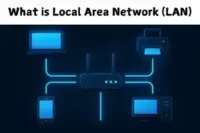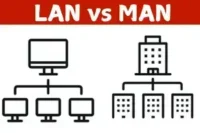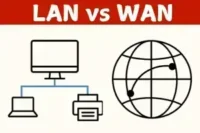Advantages and Disadvantages of Point-to-Point Topology
Published: February 12, 2025
Understanding the advantages and disadvantages of Point-to-Point topology helps determine whether it suits specific networking needs. This article will explore how this topology works, its benefits and potential drawbacks.

What is Point-to-Point Topology?
Point-to-point topology refers to a network configuration in which a direct link exists between two devices, such as computers, routers, or switches. Unlike other network topologies that involve multiple connections or intermediaries, Point-to-Point connections ensure direct communication between just two endpoints.
Examples of Point-to-Point Topology
- Wired Communication: Ethernet crossover cables connecting two computers.
- Wireless Links: Direct Bluetooth or infrared connections between devices.
- Leased Lines: Dedicated fiber-optic or copper lines connecting two locations.
- Satellite Communication: A direct link between a ground station and a satellite.
Advantages of Point-to-Point Topology
Point-to-Point topology offers several benefits, making it an ideal choice for specific applications. Let’s explore these advantages:
1. Simplicity and Easy Implementation
Since only two devices are involved, setting up a Point-to-Point connection is straightforward. There is no need for complex configurations or additional hardware like switches or hubs.
2. Fast and Reliable Communication
Because there is a dedicated link between the two devices, data transmission is quick and efficient. The absence of intermediate nodes reduces latency and minimizes the chances of congestion.
3. High Security
A direct connection between two devices ensures a higher level of security compared to shared network architectures. Unauthorized access is minimized since no other devices are involved in communication.
4. Efficient Use of Bandwidth
In a Point-to-Point network, the entire bandwidth is available for communication between the two devices. This topology allows for optimized data transfer, unlike shared networks where bandwidth is divided among multiple users.
5. Less Maintenance
With only two devices to manage, maintenance and troubleshooting are easier. If a problem occurs, it is usually related to one of the two endpoints or the connecting cable/link, making diagnosis and repairs simpler.
6. No Collisions or Data Loss
Since there is no contention for network resources, data collisions are eliminated, leading to a more stable and predictable communication channel.
7. Dedicated Connection for Critical Applications
Point-to-point connections are commonly used for critical applications requiring uninterrupted and dedicated communication, such as financial transactions, real-time monitoring, and military communications.
8. Cost-Effective for Small Networks
A Point-to-Point setup can be an economical option for small networks. It avoids the need for expensive networking devices, reducing overall costs.
9. Better Performance in Short-Distance Communication
When used for short distances, such as a direct cable link between two computers, performance is optimal with minimal interference or signal degradation.
10. Ideal for Private Connections
Organizations requiring secure, private networks often use Point-to-Point topology to ensure data confidentiality and prevent unauthorized access.
Disadvantages of Point-to-Point Topology
Despite its advantages, Point-to-Point topology has limitations that can affect its scalability and overall efficiency. Here are the main drawbacks:
1. Limited Scalability
A point-to-point topology only connects two devices. Additional direct connections must be established if the network needs to expand, leading to complexity and inefficiency.
2. Higher Cost for Large Networks
For larger networks requiring multiple direct connections, the cost of cables, interfaces, and setup increases significantly, making large-scale implementations impractical.
3. Failure of One Node Affects Communication
If one of the two devices in a Point-to-Point network fails, the entire connection is disrupted, and data transmission has no alternative path.
4. Not Suitable for Multi-Device Communication
Unlike Star, Mesh, or Bus topologies, Point-to-Point does not allow multiple devices to communicate efficiently. Every additional device requires a new dedicated connection.
5. Distance Limitations
The effectiveness of Point-to-Point communication depends on the distance between the two devices. Long-distance connections may require additional hardware like repeaters, amplifiers, or leased lines, increasing costs.
6. Inflexibility in Network Design
Since each Point-to-Point connection is exclusive to two devices, reconfiguring or expanding the network can be time-consuming and expensive.
7. Increased Cable Management Complexity
If multiple Point-to-Point connections are used within an organization, managing the cables and connections becomes difficult, leading to potential disorganization and maintenance challenges.
8. Limited Redundancy
Unlike Mesh or Ring topologies, where multiple paths exist, Point-to-Point connections lack redundancy. If a connection is lost, there is no alternative route for communication.
9. Not Ideal for Dynamic Networks
Point-to-point topology is not practical in environments where devices frequently join and leave the network. Dynamic networks require more flexible configurations, such as wireless mesh or client-server models.
10. Can Be Costly for High-Speed Links
Leasing a dedicated point-to-point line can be expensive for high-speed or dedicated fiber-optic connections, making it less viable for budget-conscious organizations.
Use Cases of Point-to-Point Topology
Despite its limitations, Point-to-Point topology is widely used in various applications, such as:
- Telecommunication Networks: Used for direct connections in telephone and broadband networks.
- Dedicated Leased Lines: Businesses use dedicated Point-to-Point connections for secure and reliable data transmission.
- IoT (Internet of Things): Many IoT devices use point-to-point communication to transfer direct sensor-to-server data.
- Military and Government Communications: Secure Point-to-Point links ensure confidential communication.
- Satellite Communications: Direct links between ground stations and satellites operate on Point-to-Point principles.
Conclusion
Point-to-Point topology is a simple yet effective network for direct communication between two devices. It offers advantages like fast data transfer, security, and reliability. However, its scalability limitations, high cost for large networks, and lack of redundancy make it unsuitable for extensive deployments.
When deciding whether to use Point-to-Point topology, consider the network size, required security level, and the need for scalability. If the network involves only two endpoints needing secure and dedicated communication, Point-to-Point topology is a great choice. However, other topologies like Star, Mesh, or Hybrid may be better suited for more extensive or dynamic networks.
Understanding the advantages and disadvantages of Point-to-Point topology ensures you make informed decisions when designing or optimizing a network.
FAQS About Point-to-Point Topology Advantages and Disadvantages
No, they are different. Point-to-Point topology is a direct link between two devices, while peer-to-peer networks involve multiple devices sharing resources without a central server.
No, a Point-to-Point topology only connects two devices directly. You would need multiple Point-to-Point connections or a different topology like Star or Mesh to add more devices.
Yes, in many cases, because it has a dedicated link, ensuring no data collisions or delays. However, if the connection is long-distance, speed may depend on the quality of the link.
Not always. A direct cable connection between two devices does not need extra hardware, but routers or leased lines might be required for long distances.
It is more secure than shared networks because only two devices are involved. However, security depends on encryption and the physical protection of the connection.
The entire communication stops. Since there’s no alternative route, both devices must be active for the connection to work.
It’s cost-effective for small setups, as it requires minimal equipment. However, large-scale networks with multiple direct connections can quickly add up costs.
Yes! Wireless point-to-point connections exist, such as Bluetooth, infrared, and dedicated Wi-Fi links between two devices.
It depends on the use case. It’s great for direct, fast, and private communication, but it’s not scalable or redundant like Mesh or Star topology.
Not directly. The Internet is based on interconnected networks, but some leased lines or VPNs use Point-to-Point connections for private and secure communication.





